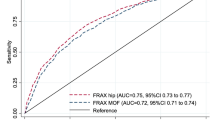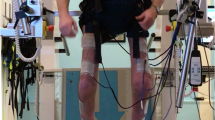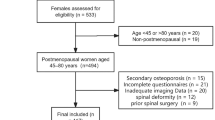Abstract
Study design:
Cross-sectional.
Objectives:
The objective of the study was to determine and report agreement in fracture risk stratification of adults with spinal cord injury (SCI) using (1) Canadian Association of Radiologists and Osteoporosis Canada (CAROC) and Canadian Fracture Risk Assessment (FRAX) tools with and without areal bone mineral density (aBMD) and (2) SCI-specific fracture thresholds.
Setting:
Tertiary rehabilitation center, Ontario, Canada.
Methods:
Community-dwelling adults with chronic SCI (n=90, C2-T12, AIS A–D) consented to participation. Femoral neck aBMD values determined 10-year fracture risk (CAROC and FRAX). Knee-region aBMD and distal tibia volumetric BMD values were compared to SCI-specific fracture thresholds. Agreements between CAROC and FRAX risk stratifications, and between fracture threshold risk stratification, were assessed using prevalence- and bias-adjusted Kappa statistics (PABAK).
Results:
CAROC and FRAX assessment tools showed moderate agreement for post-menopausal women (PABAK=0.56, 95% confidence interval (CI): 0.27, 0.84) and men aged ⩾50 years (PABAK=0.51, 95% CI: 0.34, 0.67), with poor agreement for young men and pre-menopausal women (PABAK⩽0). Excellent agreement was evident between FRAX with and without aBMD in young adults and in those with motor incomplete injury (PABAK=0.86–0.92). In other subgroups, agreement ranged from moderate to substantial (PABAK=0.41–0.73). SCI-specific fracture thresholds (Eser versus Garland) showed poor agreement (PABAK⩽0).
Conclusion:
Fracture risk estimates among individuals with SCI vary substantially with the risk assessment tool. Use of SCI-specific risk factors to identify patients with high fracture risk is recommended until a validated SCI-specific tool for predicting fracture risk is developed.
Similar content being viewed by others
Log in or create a free account to read this content
Gain free access to this article, as well as selected content from this journal and more on nature.com
or
References
Morse L, Teng YD, Pham L, Newton K, Yu D, Liao WL et al. Spinal cord injury causes rapid osteoclastic resorption and growth plate abnormalities in growing rats (SCI-induced bone loss in growing rats). Osteoporos Int 2008; 19: 645–652.
Maïmoun L, Couret I, Mariano-Goulart D, Dupuy AM, Micallef J-P, Peruchon E et al. Changes in osteoprotegerin/RANKL system, bone mineral density, and bone biochemicals markers in patients with recent spinal cord injury. Calcif Tissue Int 2005; 76: 404–411.
Jiang S-D, Dai L-Y, Jiang L-S . Osteoporosis after spinal cord injury. Osteoporos Int 2006; 17: 180–192.
Kanis JA, Adachi JD, Cooper C, Clark P, Cummings SR, Diaz-Curiel M et al. Standardising the descriptive epidemiology of osteoporosis: recommendations from the Epidemiology and Quality of Life Working Group of IOF. Osteoporos Int 2013; 24: 2763–2764.
Garland D, Adkins R, Stewart C . The natural history of bone loss in the lower extremity of complete spinal cord-injured males. Top Spinal Cord Inj Rehabil 2005; 11: 48–60.
Zehnder Y, Lüthi M, Michel D, Knecht H, Perrelet R, Neto I et al. Long-term changes in bone metabolism, bone mineral density, quantitative ultrasound parameters, and fracture incidence after spinal cord injury: a cross-sectional observational study in 100 paraplegic men. Osteoporos Int 2004; 15: 180–189.
Craven BC, Giangregorio L, Robertson L, Delparte JJ, Ashe MC, Eng JJ . Sublesional osteoporosis prevention, detection, and treatment: a decision guide for rehabilitation clinicians treating patients with spinal cord injury. Crit Rev Phys Rehabil Med 2008; 20: 277–321.
Craven BC, Lynch CL, Eng JJ. In: Eng JJ, Teasell RW, Miller WC, Wolfe DL, Townson AF, Hsieh JTC, et al. (eds). Spinal Cord Injury Rehabilitation Evidence, Version 5.0. SCIRE: Vancouver, BC, Canada. 2014, pp 1–37.
Papaioannou A, Morin S, Cheung AM, Atkinson S, Brown JP, Feldman S et al. 2010 clinical practice guidelines for the diagnosis and management of osteoporosis in Canada: summary. CMAJ 2010; 182: 1864–1873.
Leslie WD, Lix LM, Langsetmo L, Berger C, Goltzman D, Hanley DA et al. Construction of a FRAX® model for the assessment of fracture probability in Canada and implications for treatment. Osteoporos Int 2011; 22: 817–827.
Lentle B, Cheung AM, Hanley DA, Leslie WD, Lyons D, Papaioannou A et al. Osteoporosis Canada 2010 guidelines for the assessment of fracture risk. Can Assoc Radiol J 2011; 62: 243–250.
Leslie WD, Berger C, Langsetmo L, Lix LM, Adachi JD, Hanley DA et al. Construction and validation of a simplified fracture risk assessment tool for Canadian women and men: results from the CaMos and Manitoba cohorts. Osteoporos Int 2011; 22: 1873–1883.
Marshall D, Johnell O, Wedel H . Meta-analysis of how well measures of bone mineral density predict occurrence of osteoporotic fractures. BMJ 1996; 312: 1254–1259.
Cranney A, Wells G, Willan A, Griffith L, Zytaruk N, Robinson V et al. Meta-analyses of therapies for postmenopausal osteoporosis. II. Meta-analysis of alendronate for the treatment of postmenopausal women. Endocr Rev 2002; 23: 508–516.
Cranney A, Tugwell P, Adachi J, Weaver B, Zytaruk N, Papaioannou A et al. Meta-analyses of therapies for postmenopausal osteoporosis. III. Meta-analysis of risedronate for the treatment of postmenopausal osteoporosis. Endocr Rev 2002; 23: 517–523.
Cranney A, Tugwell P, Zytaruk N, Robinson V, Weaver B, Adachi J et al. Meta-analyses of therapies for postmenopausal osteoporosis. IV. Meta-analysis of raloxifene for the prevention and treatment of postmenopausal osteoporosis. Endocr Rev 2002; 23: 524–528.
Craven BC, Robertson L, McGillivray C, Adachi JD . Detection and treatment of sublesional osteoporosis among patients with chronic spinal cord injury. Top Spinal Cord Inj Rehabil 2009; 14: 1–22.
Garland DE, Adkins RH, Kushwaha V, Stewart C . Risk factors for osteoporosis at the knee in the spinal cord injury population. J Spinal Cord Med 2004; 27: 202–206.
Eser P, Frotzler A, Zehnder Y, Denoth J . Fracture threshold in the femur and tibia of people with spinal cord injury as determined by peripheral quantitative computed tomography. Arch Phys Med Rehabil 2005; 86: 498–504.
Vestergaard P, Krogh K, Rejnmark L, Mosekilde L . Fracture rates and risk factors for fractures in patients with spinal cord injury. Spinal Cord 1998; 36: 790–796.
Garland D, Adkins R, Stewart C . Fracture threshold and risk for osteoporosis and pathologic fractures in individuals with spinal cord injury. Top Spinal Cord Inj Rehabil 2005; 11: 61–69.
Slade JM, Bickel CS, Modlesky CM, Majumdar S, Dudley GA . Trabecular bone is more deteriorated in spinal cord injured versus estrogen-free postmenopausal women. Osteoporos Int 2005; 16: 263–272.
Parsons KC, Lammertse DP . Rehabilitation in spinal cord disorders. 1. Epidemiology, prevention, and system of care of spinal cord disorders. Arch Phys Med Rehabil 1991; 72: S293–S294.
Ragnarsson KT, Sell GH . Lower extremity fractures after spinal cord injury: a retrospective study. Arch Phys Med Rehabil 1981; 62: 418–423.
Freehafer AA . Limb fractures in patients with spinal cord injury. Arch Phys Med Rehabil 1995; 76: 823–827.
Morse LR, Battaglino RA, Stolzmann KL, Hallett LD, Waddimba A, Gagnon D et al. Osteoporotic fractures and hospitalization risk in chronic spinal cord injury. Osteoporos Int 2009; 20: 385–392.
Carbone LD, Chin AS, Lee TA, Burns SP, Svircev JN, Hoenig HM et al. The association of opioid use with incident lower extremity fractures in spinal cord injury. J Spinal Cord Med 2013; 36: 91–96.
Carbone L, Chin AS, Lee TA, Burns SP, Svircev JN, Hoenig H et al. The association of anticonvulsant use with fractures in spinal cord injury. Am J Phys Med Rehabil 2013; 92: 1037–1046-1050.
Lala D, Craven BC, Thabane L, Papaioannou A, Adachi JD, Popovic MR et al. Exploring the determinants of fracture risk among individuals with spinal cord injury. Osteoporos Int 2014; 25: 177–185.
Brown JP, Josse RG, Scientific Advisory Council of the Osteoporosis Society of Canada. 2002 clinical practice guidelines for the diagnosis and management of osteoporosis in Canada. CMAJ 2002; 167: S1–34.
Giangregorio LM, Craven BC, Webber CE . Musculoskeletal changes in women with spinal cord injury: a twin study. J Clin Densitom 2005; 8: 347–351.
Baim S, Binkley N, Bilezikian JP, Kendler DL, Hans DB, Lewiecki EM et al. Official positions of the International Society for Clinical Densitometry and executive summary of the 2007 ISCD Position Development Conference. J Clin Densitom 2008; 11: 75–91.
Sim J, Wright CC . The kappa statistic in reliability studies: use, interpretation, and sample size requirements. Phys Ther 2005; 85: 257–268.
Kirshblum SC, Burns SP, Biering-Sorensen F, Donovan W, Graves DE, Jha A et al. International standards for neurological classification of spinal cord injury (Revised 2011). J Spinal Cord Med 2011; 34: 535–546.
Langsetmo L, Goltzman D, Kovacs CS, Adachi JD, Hanley DA, Kreiger N et al. Repeat low-trauma fractures occur frequently among men and women who have osteopenic BMD. J Bone Miner Res 2009; 24: 1515–1522.
Gifre L, Vidal J, Carrasco J, Portell E, Puig J, Monegal A et al. Incidence of skeletal fractures after traumatic spinal cord injury: a 10-year follow-up study. Clin Rehabil 2014; 28: 361–369.
Pelletier CA, Dumont FS, Leblond J, Noreau L, Giangregorio L, Craven BC . Self-report of one-year fracture incidence and osteoporosis prevalence in a community cohort of Canadians with spinal cord injury. Top Spinal Cord Inj Rehabil 2014; 20: 302–309.
Bethel M, Weaver FM, Bailey L, Miskevics S, Svircev JN, Burns SP et al. Risk factors for osteoporotic fractures in persons with spinal cord injuries and disorders. Osteoporos Int 2016; 27: 3011–3021.
Acknowledgements
We acknowledge the support of the Ontario Neurotrauma Foundation (#2009-SCI-MA-684), the Canadian Institutes of Health Research (#86521) and the Spinal Cord Injury Solutions Network (RHI) (#2010-43). Toronto Rehab-UHN receives funding from the Ontario Ministry of Health and Long-Term Care. TC is supported by Fellowship Salary Support Award of Spinal Cord Injury—Ontario. LG is the recipient of a Canadian Institutes of Health Research New Investigator Award and an Early Researcher Award from the Ministry of Research and Innovation, and infrastructure funding from the Canadian Foundation for Innovation and the Ontario Research Fund. BC is supported by a CHNF Senior Scientist Award. The views expressed herein do not necessarily reflect those of the funders.
Author information
Authors and Affiliations
Corresponding author
Ethics declarations
Competing interests
LG has received funding from Merck Canada Inc., and is a co-investigator on a project funded by Amgen Inc. JDA reports grants and personal fees from Amgen Inc., grants and personal fees from Eli Lilly, grants and personal fees from Merck Canada Inc., grants from Actavis, personal fees from Agnovos, outside the submitted work. BCC reports consulting fees from the Rick Hansen Institute. The remaining authors declare no conflict of interest.
Rights and permissions
About this article
Cite this article
Cervinka, T., Lynch, C., Giangregorio, L. et al. Agreement between fragility fracture risk assessment algorithms as applied to adults with chronic spinal cord injury. Spinal Cord 55, 985–993 (2017). https://doi.org/10.1038/sc.2017.65
Received:
Revised:
Accepted:
Published:
Issue date:
DOI: https://doi.org/10.1038/sc.2017.65
This article is cited by
-
Comparison of DXA-based versus CT-based indices to predict prevalent fracture history in men with spinal cord injury
Osteoporosis International (2023)
-
Preliminary training volume and progression algorithm to tackle fragility fracture risk during exoskeleton-assisted overground walking in individuals with a chronic spinal cord injury
Spinal Cord Series and Cases (2022)
-
Bone Loss and the Current Diagnosis of Osteoporosis and Risk of Fragility Fracture in Persons with Spinal Cord Injury
Current Physical Medicine and Rehabilitation Reports (2020)
-
New Developments in Fracture Risk Assessment for Current Osteoporosis Reports
Current Osteoporosis Reports (2020)
-
Incidental bilateral calcaneal fractures following overground walking with a wearable robotic exoskeleton in a wheelchair user with a chronic spinal cord injury: is zero risk possible?
Osteoporosis International (2020)



